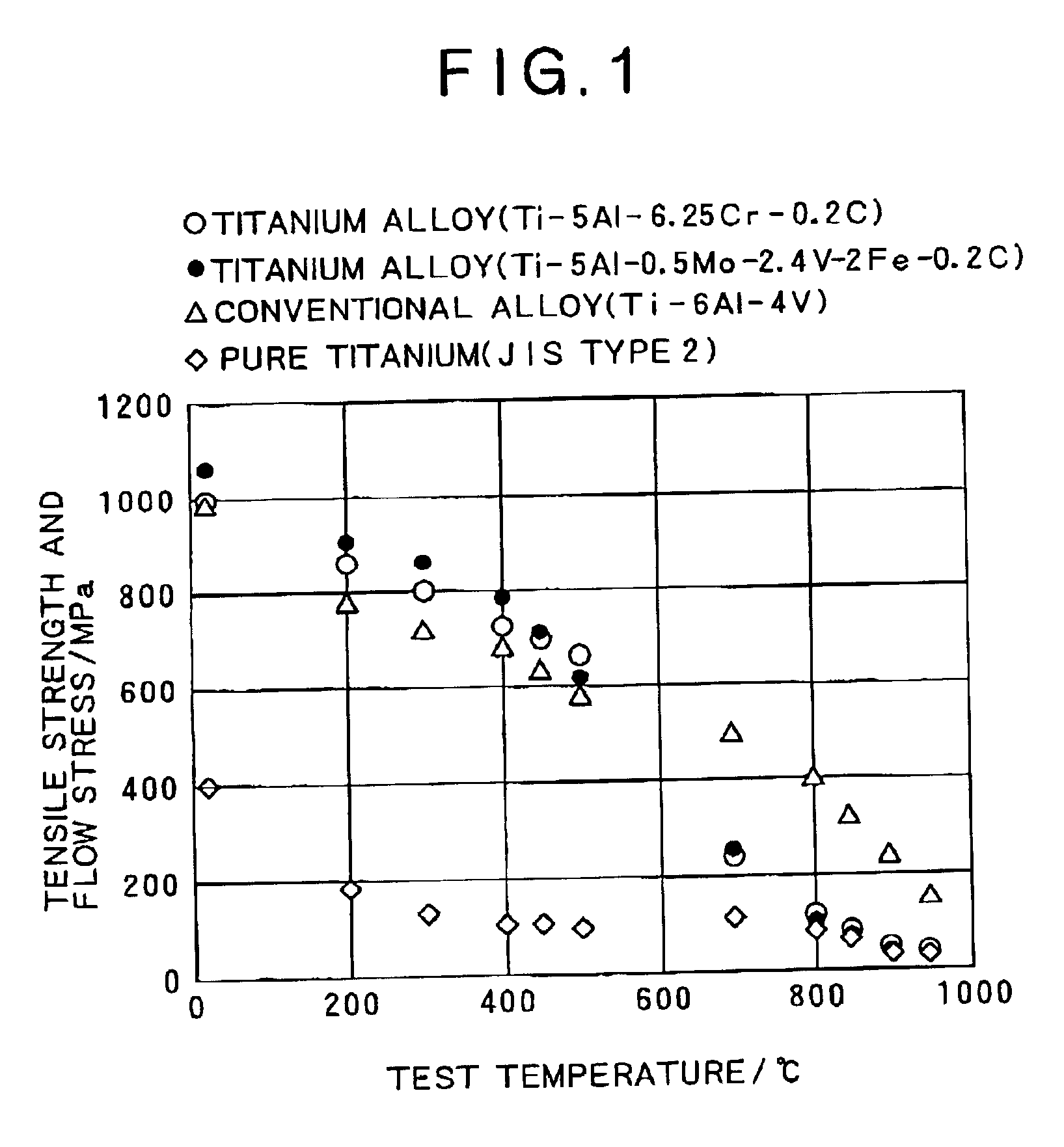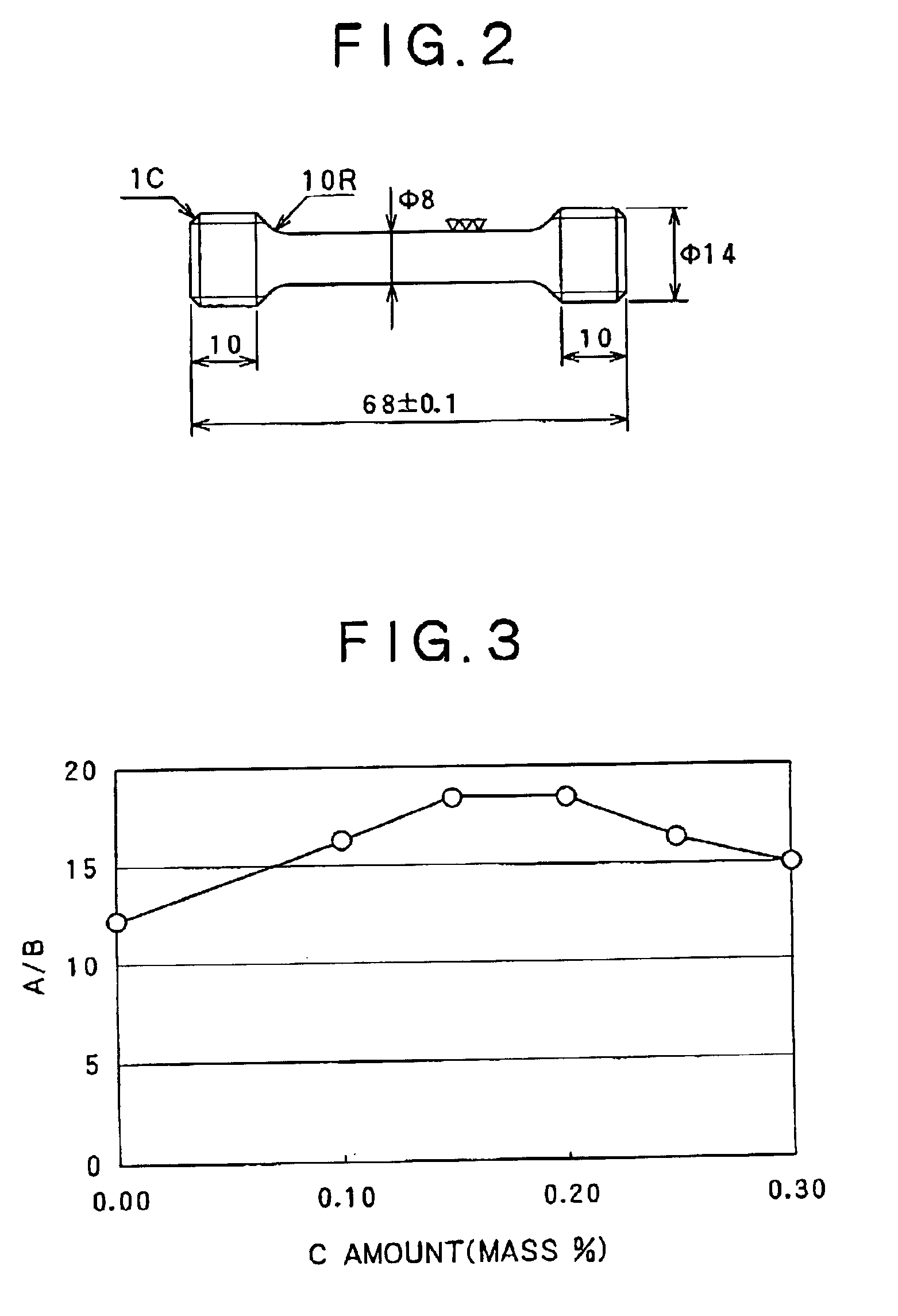Alpha-beta type titanium alloy
a titanium alloy, beta-beta technology, applied in the field of titanium alloys, can solve the problems of large working heat generation, low forgeability and secondary workability of high-strength titanium alloys, and large work heat generation, and achieve excellent hot workability, low cost, and high work efficiency.
- Summary
- Abstract
- Description
- Claims
- Application Information
AI Technical Summary
Benefits of technology
Problems solved by technology
Method used
Image
Examples
example 1
As typical titanium alloys in accordance with the present invention, a Ti-5Al-6.25Cr-0.2C alloy (1) (peritectoid reaction temperature: 915° C.), a Ti-5Al-0.5Mo-2.4V-2Fe-0.2C alloy (2) (peritectoid reaction temperature: 967° C.), and a Ti-4.5Al-4Cr-0.5Fe-0.2C alloy (3) (peritectoid reaction temperature: 970° C.) were melt-produced and cast by a cold crucible induction melting method (CCIM) to manufacture 25-kg ingots. Each of the resulting ingots of the alloys (1) and (2) were heated to 1000° C. as a preferred heating temperature slightly lower than normal, followed by preforging at a working ratio of 80%. Then, the ingots were heated to 850° C., followed by finish forging at a working ratio of 75%. Whereas, each of the resulting ingots of the alloy (3) was heated at 850° C. for 2 hours, followed by forging at a working ratio of 92%. Thereafter, all the ingots of the alloys (1) to (3) were heated at 700° C. for 2 hours, followed by air cooling, thus to be annealed. In consequence, fo...
example 2
By using the titanium alloys having their respective compositions shown in Table 4 below, 25-kg ingots were manufactured by adopting a cold crucible induction melting method. Each of the resulting ingots was heated to 850° C., and then a forged round bar with a diameter of 25 mm was manufactured. The resulting round bar was annealed at 700° C. for 2 hours. Subsequently, the annealed material was measured for its tensile strength at room temperature (in accordance with ASTM E8) and its flow stress at 850° C. by the same method. The results are shown together in Table 4.
TABLE 4Tensile strength (MPa) of 700° C.β transformationannealed material850° C. flow stress (B) (MPa) of 1000° C. ×Ref. No.Alloy composition (mass%)point (° C.)25° C. tensile strength (A)30 min / AC materialA / B1Ti-4.5Al-4Cr-0.5Fe9076905512.52Ti-4.5Al-4Cr-0.5Fe-0.1C9459045516.43Ti-4.5Al-4Cr-0.5Fe-0.15C9709765318.44Ti-4.5Al-4Cr-0.5Fe-0.2C9709825318.55Ti-4.5Al-4Cr-0.5Fe-0.25C9709005516.46Ti-4.5Al-4Cr-0.5Fe-0.3C9708455615.1...
example 3
Melt-producing, casting, forging, and annealing were performed in the precisely same manner as in Example 1, except that the alloys indicated by reference characters a and b shown in Table 5 were used as examples of the titanium alloys intended principally for the enhancement in strength at from room temperature to 500° C. Each of the resulting annealed materials was measured in the same manner for the ordinary-temperature (25° C.) and high-temperature (500° C.) tensile strengths and the flow stress upon greeble test at 850° C. In consequence, the results shown together in Table 5 were obtained. Further, in Table 5, the values in the case where a Ti-6Al-4V alloy was used as a typical conventional alloy are shown together for comparison.
TABLE 5Tensile strength (MPa) of700° C. annealed material850° C. flow stress (B)β transformation25° C. tensile500° C. tensile(MPa) of 1000° C. × 30Ref. No.Alloy composition (mass%)point (° C.)strength (A)strength (C)min / AC materialA / BC / A(%)aTi-6Al-4Sn...
PUM
| Property | Measurement | Unit |
|---|---|---|
| Temperature | aaaaa | aaaaa |
| Temperature | aaaaa | aaaaa |
| Temperature | aaaaa | aaaaa |
Abstract
Description
Claims
Application Information
 Login to View More
Login to View More - R&D
- Intellectual Property
- Life Sciences
- Materials
- Tech Scout
- Unparalleled Data Quality
- Higher Quality Content
- 60% Fewer Hallucinations
Browse by: Latest US Patents, China's latest patents, Technical Efficacy Thesaurus, Application Domain, Technology Topic, Popular Technical Reports.
© 2025 PatSnap. All rights reserved.Legal|Privacy policy|Modern Slavery Act Transparency Statement|Sitemap|About US| Contact US: help@patsnap.com



